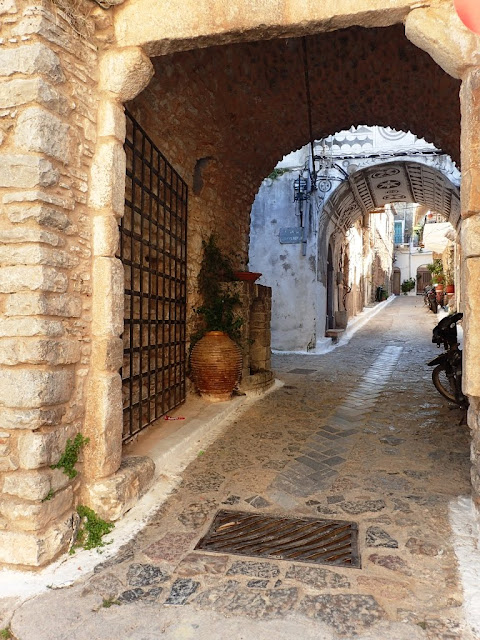Chios has quite a chequered and sad history. As with all the islands in the Aegean, Chios has
been occupied by the various empires; Greek, Roman, Byzantine, Venetian,
Genoese and Ottoman. Throughout these
occupations the villagers, as villagers always do, just got on with their lives
as best they could, raising their crops and herding their goats.
One of the special crops grown in the southern part of the island
was Mastic. Mastic is a gum resin from
the Mastic tree, an evergreen shrub that thrives in the arid, stony soil of
southern Chios. This is the only place
in the world where the climatic conditions are just right to produce the mastic
resin. The resin has been a major trade
commodity since antiquity and used in medicine, cooking, religious ceremonies
and cosmetics. To protect this valuable
commodity from the frequent pirate raids, the Genoese in the 13th
Century build fortified villages in the hills called Mastichochoria. These medieval villages were the main attraction
for our visit to the island.
 |
| Mastic Village |
Our first stop was the Mastic museum just outside the
village of Pygri.
This is an excellent
museum with very informative and first-rate exhibits explaining the whole
production of the mastic resin, its history and commercialisation.
A mastic tree can live for 100 years.
It starts production of resin after about 6 years
with production peaking at 15 years and declines dramatically after 70
years.
Peak production is only about 200
grams of resin per tree.
The harvesting
is all done by hand.
Small incisions are
made in the bark of the tree and the resin drops, ‘the tears of Chios’ are
collected and cleaned in a long labour intensive and multi-stepped process.
 |
| The mastic tree |
 |
| The leaves of a mastic tree |
 |
| The tears of Chios |
Then on to the villages.
We visited two of the seven villages, Olympi and Masta.
These walled downs are a labyrinth of narrow
alleys and small dark houses opening up to the occasional delightful square
with wonderful tavernas.
 |
| Enjoying a Chios beer and a sample of Mastika, the liqueur made from mastic |
 |
| The decorative walls of the village |
Insert photos
The population of the villages now is much reduced. Given the history of Chios, the villages’
survival is just short of a miracle.
Although the mastic villages enjoyed special privileges during the
Ottoman rule, when the island joined the Greek War of Independence in 1822, over
50,000 of Chios residents were slaughtered, another 50,000 managed to flee the
carnage leaving only about 20,000 Greeks left on the island.
Then about 60 years later a strong earthquake destroyed
many of the buildings and killed another 10,000 inhabitants. Finally in recent years several large forest
fires have destroyed many of the trees.
We drove through many bare hillsides with only the stumps of charred
trees remaining. I didn’t take any
photos. It was all too sad. I hope the resilience of the
people of the Mastichochoria will ensure the tradition of mastic cultivation continues. They have survived slaughter and earthquakes but can they and the trees survive the effects of climate change??
 |
| Spring flowers were everywhere |
 |
| The quiet village square |












No comments:
Post a Comment